Eduard Vallès
If there is a Catalan artist who evokes the painting of light like few others, it is Joaquim Mir (Barcelona 1873-1940). For example, the subliminal and almost dreamlike landscapes of the coasts of Mallorca, or the relentless sun over the landscapes of Tarragona, incorporate plastic values that transfer the painting to a high level of sensory perception.
All these landscapes or the like, which humans can know as a lived experience, few have painted them so faithful to the senses, but paradoxically so far from the strict reality, as Joaquim Mir has done so. This text does not treat Mir as a creator per se – although he is – but as an object of attention, and of representation, by Picasso for around five years.
A crossroads at the turn of the century
It is little known that Picasso did more than a dozen portraits of him that reveal the extent to which he followed his work and, in return, how aware he was of the evolution of Catalan art of his time. A Catalan art that Picasso was lucky enough to live in one of the brightest moments of its history, when it was bursting with vigor who has been, possibly, the greatest landscape painter that has come out of Catalan art, and one of the best of the European art of his time.
Paradoxically, of the great contemporary Catalan artists, Mir was one of the few who did not make the trip to Paris, but as a landscape painter, he was the most modern and unique of all due to the adoption of visual codes, especially from his stay of Mallorca, which would place him in the pantheon of great landscape painters. From a very early age he led a very solid career with an absolutely personal language as a landscape painter, going through perfectly defined phases, stylistic evolutions and geographical areas (Barcelona, Mallorca, Camp de Tarragona, Vilanova i la Geltrú, etc.), with the legendary confinement for a couple of years in the Institut Psiquiàtric Pere Mata de Reus. (The Psychiatric Hospital of Reus).
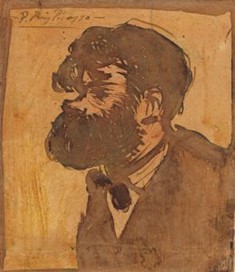
During the beginnings of his artistic career, Mir came across a young Picasso when the former had a certain prestige and the latter was nothing more than an unknown student of Fine Arts having just arrived from A Coruña, who was just being seen in Barcelona for the first time. Both coincided – although both of them would come and go from the city – between 1895 and 1904. During this period, Picasso produced more than a dozen portraits of him, although in this text we will only cite the most relevant, for their quality and underlying discourse.
We have very little information about their personal relationship and it remains unclear in which terms it would have been. But the truth is that both were in different strata, vital and, of course, prestigious. Mir, eight years older than Picasso, was beginning an important career and was included in the Catalan avant-garde of the time, while Picasso still painted customary and religious scenes with a teacher from the Llotja – or even his father – correcting him from behind.

Picasso’s relationship with Mir – as with so many other Catalan artists – helps us to explain, but above all to redefine, the role of Catalan art on Picasso, regularly banished or diminished by international experts, who often do not know the influence of the Catalan artistic context in the genesis of Picasso.
Mir seen by Picasso
By analysing the portraits that Picasso did of Mir, they tell us about a surprising iconographic repertoire, the result of a fairly intense monitoring: First, due to the number of portraits, which would make Picasso one of the artists who portrayed Mir most, despite the relative little contact they had. The case of Mir’s portraits is interesting because they extend over a period of 5 to 6 years, and in three different periods: most date from the two-year period of 1899-1900; at least one portrait is from 1903 and a final portrait dates from 1905, carried out in Paris when both artists were no longer in contact. Secondly, and most importantly, it is worth highlighting the iconological interpretation of some of these portraits, an interpretation that confirms to us how finely tuned Picasso always was and how he knew to interpret in real time the moment he was living inside Catalan art. Before going into the portraits, an indicator of the Picasso followed Mir’s can be seen when Picasso imitates – literally – his signature (“J. Mir”), such as, for example, the drawing Self-portrait chiaroscuro, and other sketches in which we can see the signatures of Casas and of Joaquim Mir (at the top on the left). This is not an isolated case, Picasso did the same with other artists such as Casas, Rusiñol and Steinlen, for example. One of Mir’s signatures goes almost unnoticed in the middle of a drawing where Picasso compulsively practises – and quite successfully – the signature of Casas, as well as the female character of the famous headline of Casas for the magazine Pèl i Ploma.
As was the custom in Picasso, when he portrayed someone he used to fix an archetype that he replicated, more or less modulated or evolved, in successive portraits. If we review the portraits, we will see that a common rule has been met in Picasso: portraying the same model using as many techniques as possible. In the case of Mir we would see portraits in ink, in watercolour, in pencil, in coloured pencil, in gouache, etc. It was actually an ‘unmuscular’ way to start from the most diverse techniques, a very common practice that he carried out throughout his career, often from the same work.
Inside Mir’s iconographic gallery, broadly speaking, we detect two very definite lines of portraits: the portraits of the profile face, and the portraits standing while walking.
A singular effigy
Regarding the former, Picasso stared at Mir’s feral face, with that jungle beard that gave him a wildest image. These are, without a doubt, the most well-finished and successful portraits, where Picasso almost always shows the same profile, the left. One of the portraits, in ink and watercolour, is in the Museu Picasso of Barcelona, and another was auctioned by Sotheby’s in 2012.
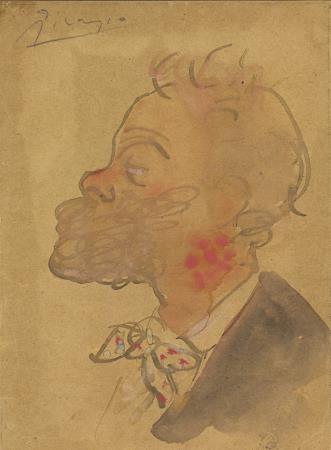
A third is probably earlier than these two, since it is still signed “P.Ruiz Picasso” and it is currently included in the collections of the Metropolitan Museum of Art of New York.
This last portrait is one of the few illustrations that Picasso produced for the magazine Pèl i Ploma, and was published in issue 81 in October 1901. Although the portrait was published in 1901, it is actually earlier and would date from the previous year, the time when Picasso began to frequent Els 4Gats.
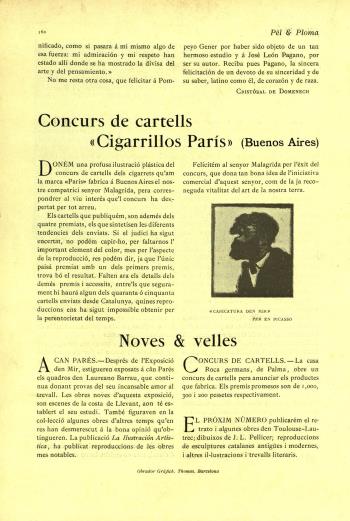
As a curiosity, in this same issue of Pèl i Ploma the portrait was published that Casas did of Joaquim Mir, this of the right profile, currently in the Museu Nacional.
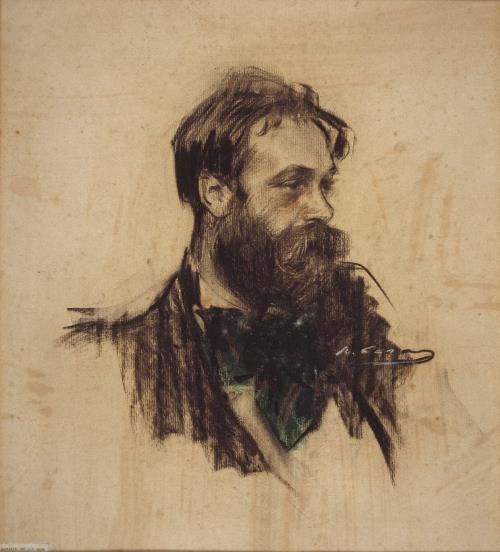
Picasso and Casas, apart from sharing space in the magazine, portrayed Mir in profile and focus on his rough face, the part of his physiology that was most plastic to them. It should be remembered that a large majority of Casas’ portraits for his iconographic gallery were of the whole body, with certain exceptions in which he was only portrayed the bust or three-quarters, for example.
Portraits in the plein air
The second line of portraits, in which Mir is seen walking through open spaces – technically the weakest – provides the paradox that is the most interesting in terms of interpretation. But before entering into this, another portrait of Mir in profile should be mentioned – again on the left – which is a work of intersection that links both groups of portraits, in the sense that it hides a double meaning. It is a portrait owned by the Fundació Mascort of Torroella de Montgrí, in gouache, with the handwritten annotation of the artist “The one of the Sun” (Portrait of Joaquim Mir).

This portrait is part of a larger set, and is executed on a series of business cards from the Junyer Vidal brothers’ yarn shop on Carrer Argenteria in Barcelona, dating back to 1903. Most of the cards, such as this one, were signed decades later, because at the time they were nothing more than simple amusements, which is why Picasso did not sign them. In fact, he portrayed other characters in the same medium, identifying those portrayed with nicknames, or hypocritical forms: for example, the portrait of Pompey Gener he entitled it as “Peyo”, Pere Romeu as “El Cafetero” , etc. But with the mention of Mir, “The one of the Sun”, Picasso did not make a simple face but, although playfully, he was revealing to us the role of Mir as a great painter of light within the Catalan and Spanish artistic ecosystem.
We have described this last portrait as a hinge so that the two most prominent portraits in the second series, walking through open spaces, show Mir illuminated by a huge sun looking at the artist with an angry face.
Mir holds in one hand the box of paintings and in the other a painting on which you can see his signature, again faithfully copied. Next to him, a dog accompanies him with two pots of paint in its mouth, and on one of which you can read the word cadmium, in reference to this so vibrant variant of the colour yellow. These two drawings, probably one being a sketch of the other, date from around 1900, and show how Picasso followed very closely the work of Joaquim Mir, a painter who used to work in plein air. When Picasso drew “The one of the Sun”, he did it at least seven years since Picasso had probably known Mir’s work, precisely when he formed part of the Colla del Safrà (The Saffron Group) a name that came from the yellowish chromatisms of the paintings of that heterogeneous group of artists.
The Fine Arts Exhibition of 1896, a meeting point
Picasso may have got to know Mir’s work during the Exposició Provincial de Belles Arts de 1896 (The Provincial Exhibition of Fine Arts of 1896) when Mir and Picasso coincided in exhibiting their works. For Picasso was the first time he presented his works in public in Barcelona, and he did so at the Palau de Belles Arts with the well-known The First Communion (1896), a conventional academic task, but with the merit of having been produced by a young man of only fourteen years old.

On the other hand, Mir was already an important value and presented two works that have become emblematic in his early production: The rector’s vegetable garden and The orange seller, both from 1896.
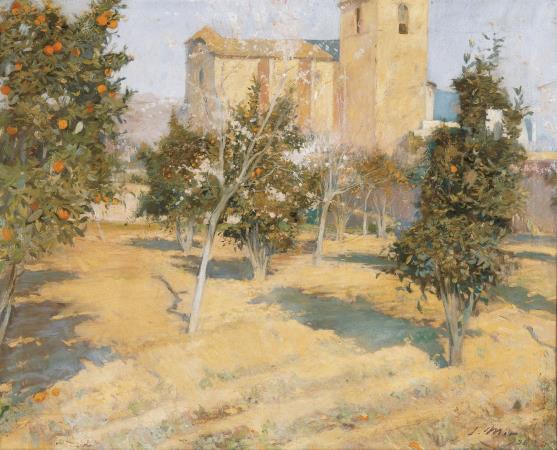
The second work shows an image of full sunlight, with very intense yellows, which flood the building at the bottom of the composition, the old façade – that is no longer – of the church of Sant Josep Oriol of Santa Coloma de Gramenet. Obviously, at that time both artists were in absolutely opposed aesthetic positions but, curiously, that same 1896, Picasso would do several paintings of landscapes with also very shrill yellows, in contrast to his freer work, and not to mention what he did in Llotja . But that would call for another article.
Almost certainly Picasso would have strolled through the rooms of the Palau de Belles Arts (The Palace of Fine Arts) especially the seventh room where artists such as Mir, Nonell and Pichot exhibited, a room that became famous for its bright landscapes, and which received great praise from one of the referential critics of Modernism, Raimon Casellas. That exhibition, and more specifically that room, was the culmination of what is known as the Colla del Safrà (The Saffron Group) which had already existed for some time, at least since 1893.
This group of artists, some of whom had dropped out of the Llotja classes, represented a local variation of Impressionism, focusing on banal landscapes and settings of the big city, based on the effects of fog or full sunlight. Names such as Mir, Juli Vallmitjana, Isidre Nonell, Joaquim Sunyer or Ramon Pichot, some of the “modern ones” of the time would be some of the most prominent members. Of all of them, Mir was the most brilliant and long-lived landscape painter, hence in 1903 Picasso still portrayed him as “The one of the Sun”.
During the first half of 1901, Picasso created a coastal landscape reminiscent of Mir’s work, but at the end of that year, the Blue Period would begin in Paris and, from then on, his work would no longer have anything to do with what Mir was doing.
A last portrait, in Paris
Nor does it seem that his personal relationship would have continued, although Picasso would remember him in 1905, while in Paris, portraying Mir again with his wild beard. He portrayed him alongside the musician Joan Gay and the businessman and collector Alexandre Riera, but the most surprising thing is that he immortalized him in a foreshortened perspective, from the bottom up, just like the 1900 drawing auctioned by Sotheby’s, mentioned above. Therefore, he portrayed him no more and no less than five years later and without having the model in front of him. And not only did he do a portrait but two, one in blue pencil and the other in ink, to which an unknown hand had added the handwritten note “Joaquim Mir peintre catalan”.
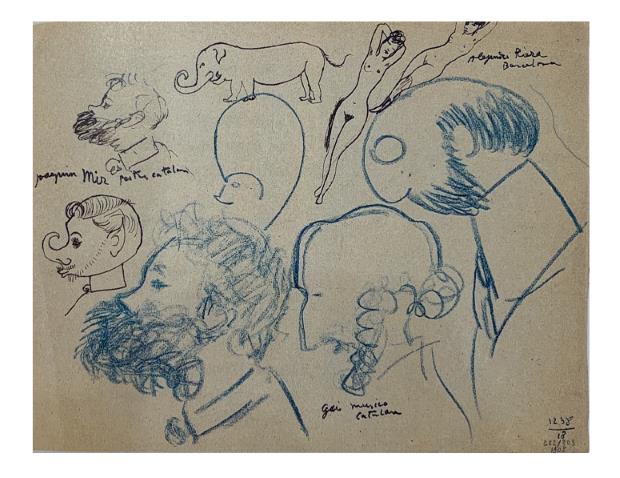
We do not know the Saint of what, Picasso again portrayed Mir in Paris. Perhaps because he remembered the Barcelona he had left only a year before, among so many other revelations, he had met one of the best and most unique landscape painters of his time?
Related links
Mariano Andreu in the Museu Nacional
Joaquim Mir’s Majorcan stained glass triptych, The Blue Pool
Art modern i contemporani







